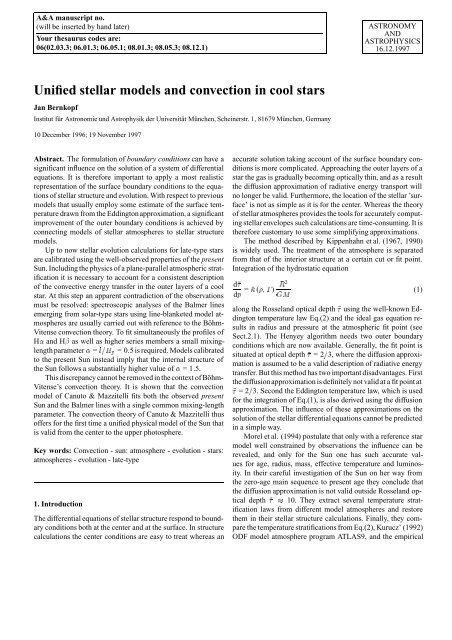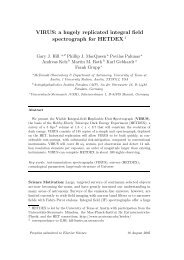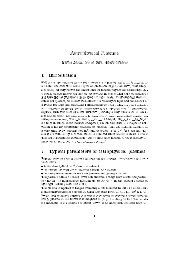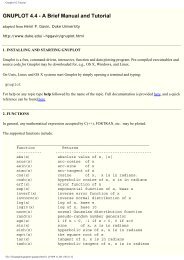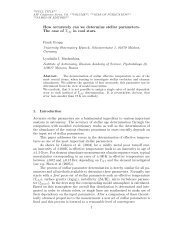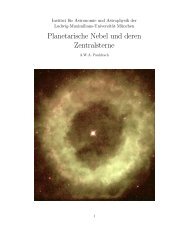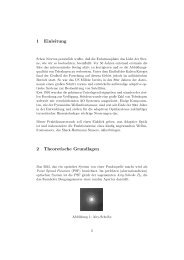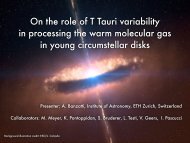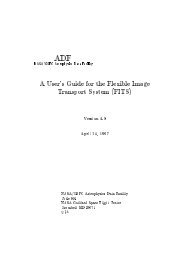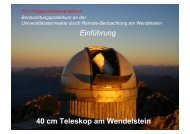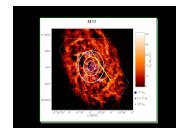Unified stellar models and convection in cool stars - Universitäts ...
Unified stellar models and convection in cool stars - Universitäts ...
Unified stellar models and convection in cool stars - Universitäts ...
Create successful ePaper yourself
Turn your PDF publications into a flip-book with our unique Google optimized e-Paper software.
A&A manuscript no.<br />
(will be <strong>in</strong>serted by h<strong>and</strong> later)<br />
Your thesaurus codes are:<br />
06(02.03.3; 06.01.3; 06.05.1; 08.01.3; 08.05.3; 08.12.1)<br />
ASTRONOMY<br />
AND<br />
ASTROPHYSICS<br />
16.12.1997<br />
<strong>Unified</strong> <strong>stellar</strong> <strong>models</strong> <strong>and</strong> <strong>convection</strong> <strong>in</strong> <strong>cool</strong> <strong>stars</strong><br />
Jan Bernkopf<br />
Institut für Astronomie und Astrophysik der Universität München, Sche<strong>in</strong>erstr. 1, 81679 München, Germany<br />
10 December 1996; 19 November 1997<br />
Abstract. The formulation of boundary conditions can have a<br />
significant <strong>in</strong>fluence on the solution of a system of differential<br />
equations. It is therefore important to apply a most realistic<br />
representation of the surface boundary conditions to the equations<br />
of <strong>stellar</strong> structure <strong>and</strong> evolution. With respect to previous<br />
<strong>models</strong> that usually employ some estimate of the surface temperature<br />
drawn from the Edd<strong>in</strong>gtonapproximation, a significant<br />
improvement of the outer boundary conditions is achieved by<br />
connect<strong>in</strong>g <strong>models</strong> of <strong>stellar</strong> atmospheres to <strong>stellar</strong> structure<br />
<strong>models</strong>.<br />
Up to now <strong>stellar</strong> evolution calculations for late-type <strong>stars</strong><br />
are calibrated us<strong>in</strong>g the well-observed properties of the present<br />
Sun. Includ<strong>in</strong>g the physics of a plane-parallel atmospheric stratification<br />
it is necessary to account for a consistent description<br />
of the convective energy transfer <strong>in</strong> the outer layers of a <strong>cool</strong><br />
star. At this step an apparent contradiction of the observations<br />
must be resolved: spectroscopic analyses of the Balmer l<strong>in</strong>es<br />
emerg<strong>in</strong>g from solar-type <strong>stars</strong> us<strong>in</strong>g l<strong>in</strong>e-blanketed model atmospheres<br />
are usually carried out with reference to the Böhm-<br />
Vitense <strong>convection</strong> theory. To fit simultaneously the profiles of<br />
H <strong>and</strong> H as well as higher series members a small mix<strong>in</strong>glength<br />
parameter = l=H p =0:5 is required. Models calibrated<br />
to the present Sun <strong>in</strong>stead imply that the <strong>in</strong>ternal structure of<br />
the Sun follows a substantially higher value of =1:5.<br />
This discrepancy cannot be removed <strong>in</strong> the context of Böhm-<br />
Vitense’s <strong>convection</strong> theory. It is shown that the <strong>convection</strong><br />
model of Canuto & Mazzitelli fits both the observed present<br />
Sun <strong>and</strong> the Balmer l<strong>in</strong>es with a s<strong>in</strong>gle common mix<strong>in</strong>g-length<br />
parameter. The <strong>convection</strong> theory of Canuto & Mazzitelli thus<br />
offers for the first time a unified physical model of the Sun that<br />
is valid from the center to the upper photosphere.<br />
Key words: Convection - sun: atmosphere - evolution - <strong>stars</strong>:<br />
atmospheres - evolution - late-type<br />
1. Introduction<br />
The differential equations of <strong>stellar</strong> structure respond to boundary<br />
conditions both at the center <strong>and</strong> at the surface. In structure<br />
calculations the center conditions are easy to treat whereas an<br />
accurate solution tak<strong>in</strong>g account of the surface boundary conditions<br />
is more complicated. Approach<strong>in</strong>g the outer layers of a<br />
star the gas is gradually becom<strong>in</strong>g optically th<strong>in</strong>, <strong>and</strong> as a result<br />
the diffusion approximation of radiative energy transport will<br />
no longer be valid. Furthermore, the location of the <strong>stellar</strong> ’surface’<br />
is not as simple as it is for the center. Whereas the theory<br />
of <strong>stellar</strong> atmospheres provides the tools for accurately comput<strong>in</strong>g<br />
<strong>stellar</strong> envelopes such calculations are time-consum<strong>in</strong>g. It is<br />
therefore customary to use some simplify<strong>in</strong>g approximations.<br />
The method described by Kippenhahn et al. (1967, 1990)<br />
is widely used. The treatment of the atmosphere is separated<br />
from that of the <strong>in</strong>terior structure at a certa<strong>in</strong> cut or fit po<strong>in</strong>t.<br />
Integration of the hydrostatic equation<br />
d¯<br />
R2<br />
=¯ ( T )<br />
dp GM<br />
along the Rossel<strong>and</strong> optical depth ¯ us<strong>in</strong>g the well-known Edd<strong>in</strong>gton<br />
temperature law Eq.(2) <strong>and</strong> the ideal gas equation results<br />
<strong>in</strong> radius <strong>and</strong> pressure at the atmospheric fit po<strong>in</strong>t (see<br />
Sect.2.1). The Henyey algorithm needs two outer boundary<br />
conditions which are now available. Generally, the fit po<strong>in</strong>t is<br />
situated at optical depth ¯ =2=3, where the diffusion approximation<br />
is assumed to be a valid description of radiative energy<br />
transfer. But this method has two important disadvantages. First<br />
the diffusionapproximation is def<strong>in</strong>itely not valid at a fit po<strong>in</strong>t at<br />
¯ =2=3. Second the Edd<strong>in</strong>gton temperature law, which is used<br />
for the <strong>in</strong>tegration of Eq.(1), is also derived us<strong>in</strong>g the diffusion<br />
approximation. The <strong>in</strong>fluence of these approximations on the<br />
solution of the <strong>stellar</strong> differential equations cannot be predicted<br />
<strong>in</strong> a simple way.<br />
Morel et al. (1994) postulate that only with a reference star<br />
model well constra<strong>in</strong>ed by observations the <strong>in</strong>fluence can be<br />
revealed, <strong>and</strong> only for the Sun one has such accurate values<br />
for age, radius, mass, effective temperature <strong>and</strong> lum<strong>in</strong>osity.<br />
In their careful <strong>in</strong>vestigation of the Sun on her way from<br />
the zero-age ma<strong>in</strong> sequence to present age they conclude that<br />
the diffusion approximation is not valid outside Rossel<strong>and</strong> optical<br />
depth ¯ 10. They extract several temperature stratification<br />
laws from different model atmospheres <strong>and</strong> restore<br />
them <strong>in</strong> their <strong>stellar</strong> structure calculations. F<strong>in</strong>ally, they compare<br />
the temperature stratifications from Eq.(2), Kurucz’ (1992)<br />
ODF model atmosphere program ATLAS9, <strong>and</strong> the empirical<br />
(1)
2 Jan Bernkopf: <strong>Unified</strong> <strong>stellar</strong> <strong>models</strong> <strong>and</strong> <strong>convection</strong> <strong>in</strong> <strong>cool</strong> <strong>stars</strong><br />
Harvard-Smithsonian Reference Atmosphere (HSRA) of G<strong>in</strong>gerich<br />
et al. (1971). The latter one suffers from the difficulty<br />
to establish the temperature distribution empirically at great<br />
optical depths. G<strong>in</strong>gerich et al. admit that their temperature is<br />
possibly 200 K too hot at ¯ = 10. The disadvantage of the<br />
Edd<strong>in</strong>gton stratification is already mentioned above, <strong>and</strong> therefore<br />
only the temperature stratifications of ODF <strong>models</strong> are<br />
sufficiently realistic. However, Morel et al. did not use one important<br />
piece of <strong>in</strong>formation <strong>in</strong> their <strong>in</strong>vestigation which seems<br />
to be well constra<strong>in</strong>ed by observation.<br />
The spectrum of a star is formed <strong>in</strong> the <strong>stellar</strong> atmosphere<br />
<strong>and</strong> therefore any model atmosphere connected to the <strong>stellar</strong><br />
structure model should represent the observed spectrum.<br />
From spectroscopic observations of the Sun, Procyon, <strong>and</strong><br />
the two metal-poor <strong>stars</strong> HD 140283 <strong>and</strong> G41-41 Fuhrmann<br />
et al. (1993) demonstrated that a precise determ<strong>in</strong>ation of a<br />
<strong>cool</strong> star’s effective temperature is determ<strong>in</strong>ed by fitt<strong>in</strong>g the observed<br />
Balmer l<strong>in</strong>es to the theoretical l<strong>in</strong>e profiles. A consistent<br />
fit to all Balmer l<strong>in</strong>es requires an adjustment of the temperature<br />
stratification <strong>in</strong> the <strong>in</strong>ner photosphere between ¯ = 1 <strong>and</strong> 10,<br />
which <strong>in</strong> turn forces the convective mix<strong>in</strong>g-length parameter to<br />
=0:5 0:3 us<strong>in</strong>g the <strong>convection</strong> model of Vitense (1953)<br />
<strong>and</strong> Böhm-Vitense (1958). This has recently been confirmed by<br />
Steffen et al. (1995), who carried out 2D hydrodynamic calculations<br />
<strong>and</strong> van’t Veer-Menneret & Mégessier (1996) who used<br />
the Kurucz ATLAS9 program <strong>and</strong> derived a mix<strong>in</strong>g-length parameter<br />
of =0:5 for the Sun <strong>and</strong> for Procyon <strong>in</strong> full agreement<br />
with Fuhrmann et al. (1993).<br />
In contrast Morel et al. worked with ATLAS9 for some temperature<br />
stratifications always with a mix<strong>in</strong>g-length parameter<br />
>1:6 which is at variance with the observation of the Balmer<br />
l<strong>in</strong>es. Van’t Veer-Menneret & Mégessier po<strong>in</strong>t at this discrepancy<br />
between the low value of =0:5 compared with a mix<strong>in</strong>glength<br />
parameter of 1.8 derived by Morel et al. for the Sun as<br />
calibration star, who found that the parameter =1:8 is the<br />
optimal choice to connect the atmosphere <strong>and</strong> the thermodynamic<br />
quantities associated with the solar <strong>convection</strong> zone to a<br />
satisfy<strong>in</strong>g accuracy. This paper will overcome the dichotomy of<br />
two mix<strong>in</strong>g-length parameters, <strong>and</strong> the conclusion will be that<br />
the problems cannot be solved with the <strong>convection</strong> model of<br />
Böhm-Vitense. Replacement of convective energy transfer by<br />
the model of Canuto & Mazzitelli (1991, 1992) will remove the<br />
outer boundary problem <strong>and</strong> lead to unified model of <strong>cool</strong> <strong>stars</strong>.<br />
A basic description of the programs <strong>and</strong> the method connect<strong>in</strong>g<br />
the model atmospheres to the <strong>stellar</strong> structure model is<br />
given <strong>in</strong> Sect. 2. Section 3 discusses the attempt to produce a<br />
consistent convective flux us<strong>in</strong>g the <strong>convection</strong> <strong>models</strong> of both<br />
Böhm-Vitense <strong>and</strong> Canuto & Mazzitelli. In Sect. 4 the results<br />
of the calculations <strong>and</strong> the conclusions are presented.<br />
2. Model <strong>in</strong>terface between <strong>stellar</strong> <strong>in</strong>terior <strong>and</strong> atmosphere<br />
The calculations described <strong>in</strong> this paper are based on the Henyey<br />
algorithm as adapted <strong>in</strong> the Kippenhahn et al. (1967) code. The<br />
program has recently been modified <strong>and</strong> described by Wagenhuber<br />
& Weiss (1994), who used the traditionalway of connect<strong>in</strong>g<br />
atmospheres to <strong>stellar</strong> structure <strong>models</strong> at ¯ =2=3. In this former<br />
version the <strong>in</strong>tegration of Eq.(1) starts at ¯ = 0 where the<br />
total gas pressure p equals the radiation pressure. The density<br />
(p T ) <strong>and</strong> the opacity ¯( T ) are evaluated with the approximation<br />
of the well-known Edd<strong>in</strong>gton temperature law,<br />
T 4 = 3 4 T 4 eff<br />
<br />
¯ + 2 3<br />
<br />
: (2)<br />
<strong>and</strong> the ideal gas equation as equation of state. The <strong>in</strong>tegration<br />
is followed out to a fit po<strong>in</strong>t at optical depth ¯ = 2=3. The<br />
local k<strong>in</strong>etic temperature at that depth is equal to the effective<br />
temperature T eff . The radius R ? of the star is def<strong>in</strong>ed with the<br />
Stefan-Boltzmann law <strong>and</strong> the total lum<strong>in</strong>osity of the star L ? .<br />
L ? =4R 2 ? T 4 eff (3)<br />
Now radius <strong>and</strong> pressure at the atmospheric fit po<strong>in</strong>t are available<br />
as functions of lum<strong>in</strong>osity <strong>and</strong> effective temperature,<br />
R f (L ? T eff ), <strong>and</strong> p f (L ? T eff ). The <strong>in</strong>terior part of the <strong>stellar</strong><br />
structure can be calculated by the well-known Henyey scheme,<br />
<strong>and</strong> for a consistent connection to the atmosphere the outermost<br />
grid po<strong>in</strong>t <strong>in</strong> that scheme must be placed at ¯ = 2=3.<br />
Furthermore the physical parameters of the atmosphere <strong>and</strong> of<br />
the <strong>in</strong>ner solution must ’fit’ at this po<strong>in</strong>t <strong>and</strong> the total mass of<br />
the <strong>stellar</strong> model should be the sum of the atmospheric <strong>and</strong> the<br />
<strong>in</strong>terior mass. In pr<strong>in</strong>ciple the conservation of total mass can<br />
be achieved by <strong>in</strong>tegrat<strong>in</strong>g the atmospheric mass <strong>and</strong> vary<strong>in</strong>g<br />
the <strong>in</strong>ner mass by <strong>in</strong>sert<strong>in</strong>g or delet<strong>in</strong>g the outermost gridpo<strong>in</strong>ts<br />
<strong>in</strong> the Henyey scheme. But often the atmospheric mass can be<br />
ignored with respect to the total mass. The physical parameters<br />
then can be fitted as follows. Lum<strong>in</strong>osity <strong>and</strong> temperature from<br />
the last Henyey iteration are taken at the outermost gridpo<strong>in</strong>t,<br />
<strong>and</strong> thus the temperature is equal to the effectiv temperature.<br />
From atmospheric <strong>in</strong>tegration R f <strong>and</strong> p f are now calculated,<br />
<strong>and</strong> they must fit the radius R o <strong>and</strong> the pressure p o at the outermost<br />
gridpo<strong>in</strong>t of the Henyey scheme. The Henyey algorithm<br />
needs two outer boundary conditions which are now available<br />
(R f ; R o =0p f ; p o = 0) <strong>and</strong> the fit will be achieved with<br />
convergence of the Henyey iteration scheme.<br />
Because of the arguments stated <strong>in</strong> the <strong>in</strong>troduction it is<br />
recommended to replace this boundary condition by a more<br />
appropriate one.<br />
2.1. New outer boundary conditions of the Henyey scheme<br />
The pr<strong>in</strong>cipal difference between the boundary condition as<br />
described <strong>in</strong> the part before <strong>and</strong> those reported here is that <strong>in</strong><br />
the latter the fit po<strong>in</strong>t is moved to ¯ = 20 which, accord<strong>in</strong>g the<br />
exam<strong>in</strong>ation of Morel et al. , is deep enough to establish the<br />
validity of the diffusion approximation.<br />
An optical depth of ¯ = 20 relates to an atmospheric depth<br />
of only 100 - 200 km <strong>in</strong> the Sun. Therefore <strong>in</strong> quiet evolution of<br />
<strong>cool</strong> unevolved <strong>stars</strong> (i.e. neglect<strong>in</strong>g pulsations) the atmosphere<br />
is neither a source nor a s<strong>in</strong>k for the energy, <strong>and</strong> it follows<br />
that the lum<strong>in</strong>osity at the fit po<strong>in</strong>t is equal to the lum<strong>in</strong>osity of<br />
the atmosphere, L f = L ? . The same argument of a negligible
Jan Bernkopf: <strong>Unified</strong> <strong>stellar</strong> <strong>models</strong> <strong>and</strong> <strong>convection</strong> <strong>in</strong> <strong>cool</strong> <strong>stars</strong> 3<br />
extension of the atmosphere is used to evaluate the radius of<br />
the star at the fit po<strong>in</strong>t such that R f = R ? . The error of this<br />
approximation can be estimated with help of Eq.(3). Vary<strong>in</strong>g<br />
the radius of the present Sun by 300 km leads to a temperature<br />
change of less then 2 K.<br />
The modified outer boundary conditions thus require the<br />
<strong>in</strong>terest<strong>in</strong>g physical variables of a grid of <strong>stellar</strong> atmosphere<br />
<strong>models</strong> to be available (see Sect.2.2). These variables are the<br />
atmospheric pressure p f <strong>and</strong> temperature T f at the fit po<strong>in</strong>t,<br />
the effective temperature T eff , radius R ? , lum<strong>in</strong>osity L ? <strong>and</strong><br />
the mass M a of the <strong>stellar</strong> atmosphere. The Henyey algorithm<br />
provides its own four physical variables at the fit pont: L o , T o , p o ,<br />
R o . Lum<strong>in</strong>osity <strong>and</strong> temperature are chosen to be <strong>in</strong>dependent,<br />
which means that the atmospheric table entry must fit both<br />
variables, L f = L o , <strong>and</strong> T f = T o . If that operation is successful<br />
one obta<strong>in</strong>s from the tables the effective temperature of the star<br />
<strong>and</strong> the two atmospheric fit po<strong>in</strong>t variables R f <strong>and</strong> p f . F<strong>in</strong>ally,<br />
the two outer boundary conditions for the Henyey scheme are<br />
available (R f = R o , p f = p o ), <strong>and</strong> the Henyey iterations will<br />
converge to these values. A two-dimensional Taylor expansion<br />
is used to <strong>in</strong>terpolate the atmospheric tables data with high<br />
accuracy.<br />
2.2. Atmospheric <strong>models</strong><br />
The <strong>models</strong> of the <strong>stellar</strong> atmospheres have been calculated<br />
us<strong>in</strong>g a plane-parallel stratification with energy transported by<br />
radiation <strong>and</strong> <strong>convection</strong> <strong>and</strong> conserved throughthe atmosphere<br />
(Gehren 1977). In addition the program <strong>models</strong> l<strong>in</strong>e-blanket<strong>in</strong>g<br />
with opacity distribution functions (ODF) provided by Kurucz<br />
(1979, 1995, <strong>and</strong> references there<strong>in</strong>). The basic <strong>in</strong>put parameters<br />
are the effective temperature T eff , the gravitational surface acceleration<br />
log g , <strong>and</strong> a set of abundance ratios by number, X/H,<br />
where X refers to all elements except hydrogen. log g relates<br />
a given <strong>stellar</strong> mass to its radius, <strong>and</strong> with T eff <strong>and</strong> Eq.(3) one<br />
obta<strong>in</strong>s the lum<strong>in</strong>osity. The atmospheric mass results from <strong>in</strong>tegration<br />
of the equation<br />
dm a = d¯ (4)<br />
¯<br />
where m is the column mass <strong>in</strong> [g cm ;2 ]. The program <strong>and</strong> the<br />
synthesis of the Balmer l<strong>in</strong>es has been described <strong>in</strong> detail by<br />
Fuhrmann et al. (1993,1996).<br />
2.3. The opacity problem<br />
Currently two sets of ODFs are available, an older set (Kurucz<br />
(1979) <strong>and</strong> a more recent one (Kurucz 1992). Compared<br />
with the 1979 data the new ODFs differ not only <strong>in</strong> their substantially<br />
extended l<strong>in</strong>e list but also <strong>in</strong> their abundance pattern.<br />
In particular the iron abundance is the subject of discussions.<br />
Whereas the 1979 data was computed with an iron abundance<br />
of log (Fe=H) = 7:55, with hydrogen number densities normalized<br />
to 10 12 , the new data uses log (Fe=H) = 7:67 with<br />
reference to results published by Blackwell et al. (1984). Holweger<br />
et al. (1990) <strong>in</strong>stead derived log (Fe=H) = 7:48, while<br />
the meteoritic value is log (Fe=H) = 7:51.<br />
There is an extended list of publications that deal with the<br />
question which of these results should be accepted as the solar<br />
iron abundance (see Holweger et al. 1991; Grevesse 1991; Hannaford<br />
et al. 1992; Grevesse & Noels 1993; Milford et al. 1994;<br />
Anstee & O’Mara 1995; Blackwell et al. 1995 <strong>and</strong> references<br />
there<strong>in</strong>; Biémont et al. 1991; Kostik et al. 1996). Currently the<br />
meteoritic iron abundance seems to be preferred. One way to<br />
deal with the new ODFs of Kurucz (1992) is to <strong>in</strong>terpolate the<br />
opacity tables us<strong>in</strong>g a ’metal’ abundance about 0.16 dex smaller<br />
than that enter<strong>in</strong>g his st<strong>and</strong>ard solar abundance mixture. This<br />
is only an approximation because iron contributes most but not<br />
all of the atmospheric l<strong>in</strong>e blanket<strong>in</strong>g. Thus for comparison the<br />
calculations have also been repeated us<strong>in</strong>g the old ODFs.<br />
The opacities at low temperatures <strong>in</strong> the evolution code<br />
provide yet another problem: the OPAL opacities (Rogers &<br />
Iglesias 1992) do not <strong>in</strong>clude entries below 6000 K. Thus Wagenhuber<br />
& Weiss (1994) implemented LAOL opacities (Weiss<br />
et al. 1990) for low temperatures. Consequently, differences of<br />
results obta<strong>in</strong>ed with either a st<strong>and</strong>ard treatment of the outer<br />
boundary condition or <strong>models</strong> with <strong>stellar</strong> atmospheres tied to<br />
the Henyey solution at ¯ = 20 may be smeared out due to the<br />
different opacities <strong>in</strong> the model atmosphere program <strong>and</strong> <strong>in</strong> the<br />
evolution code. To dist<strong>in</strong>guish these effects a table of Rossel<strong>and</strong><br />
opacities for low temperatures has been generated with the<br />
model atmosphere program. This new opacity table was used<br />
for temperatures below 10 000 K <strong>in</strong> both types of boundary<br />
conditions, with <strong>and</strong> without model atmospheres. In the f<strong>in</strong>al<br />
section it will be shown that at 10 000 K the OPAL opacities<br />
<strong>and</strong> the new opacity table fit smoothly.<br />
3. Consistent formulation of <strong>convection</strong><br />
A unified model of <strong>stellar</strong> evolution <strong>in</strong>clud<strong>in</strong>g <strong>stellar</strong> atmospheres<br />
as an outer boundary condition requires a consistent<br />
formulation of convective energy transfer, because the fit po<strong>in</strong>t<br />
at ¯ = 20 is well <strong>in</strong>side the solar hydrogen <strong>convection</strong> zone, <strong>and</strong><br />
any differences between formulations used for the model atmosphere<br />
<strong>and</strong> the <strong>stellar</strong> <strong>in</strong>terior will lead to different convective<br />
fluxes. Further any description of solar <strong>convection</strong> has to fulfil<br />
observational restrictions implied by radius <strong>and</strong> lum<strong>in</strong>osity of<br />
the present Sun, the Balmer l<strong>in</strong>e spectrum emerg<strong>in</strong>g from the<br />
surface of the Sun <strong>and</strong> by solar oscillations. Two <strong>models</strong> of<br />
<strong>convection</strong> are considered for this purpose.<br />
3.1. The model of Böhm-Vitense<br />
Mix<strong>in</strong>g-length theory as developed by Vitense (1953, see also<br />
Böhm-Vitense 1958) <strong>and</strong> formulated by Cox & Giuli (1968)<br />
seems to fit the properties of the present Sun provided the<br />
mix<strong>in</strong>g-length parameter is greater than 1.5, a value that<br />
has been used as a lower limit <strong>in</strong> many treatments of the <strong>in</strong>terior<br />
structure of the Sun. A mix<strong>in</strong>g-length parameter of =0:5 as<br />
it would be required by the observations of the Balmer l<strong>in</strong>es is<br />
outside any acceptable error limit imposed by the solar radius.<br />
However, the model of Böhm-Vitense has more free parameters<br />
than only the mix<strong>in</strong>g-length parameter , <strong>and</strong> <strong>in</strong> pr<strong>in</strong>ciple it
4 Jan Bernkopf: <strong>Unified</strong> <strong>stellar</strong> <strong>models</strong> <strong>and</strong> <strong>convection</strong> <strong>in</strong> <strong>cool</strong> <strong>stars</strong><br />
could be possible to f<strong>in</strong>d a set of parameters that fits the present<br />
Sun <strong>and</strong> the Balmer l<strong>in</strong>es.<br />
In the follow<strong>in</strong>g T , , g, C p , H p , Q, v, , , , r, r 0<br />
<strong>and</strong> r ad have their usual mean<strong>in</strong>g as given <strong>in</strong> the refernces<br />
(see Vitense 1953, Böhm-Vitense 1958 or Henyey et al. 1965).<br />
Besides a second parameter, , is found <strong>in</strong> the expression for<br />
the convective velocity v,<br />
v 2 = gH pQ 2<br />
(r;r 0 ) (5)<br />
<br />
In 1953 Vitense used = 4 whereas <strong>in</strong> Böhm-Vitense (1958)<br />
she changed to = 8 to improve the description of the turbulent<br />
friction. Henyey et al. (1965) argued that the actual value might<br />
even be somewhat greater than = 8. The equation determ<strong>in</strong><strong>in</strong>g<br />
the convective efficiency factor has two more free parameters<br />
replac<strong>in</strong>g the volume to surface ratio of a convective element<br />
<strong>and</strong> different expressions for different optical thickness ¯ of<br />
the convective bubble. Vitense (1953, her Eq.8) formulated <br />
as<br />
=<br />
C pv<br />
4T 3 volume <br />
surface ¯ : ¯ 1<br />
1<br />
¯ : ¯ 1 (6)<br />
She represented the unknown geometry by a new parameter y<br />
such that the volume to surface ratio can be written as y=2. The<br />
transition from optically thick to th<strong>in</strong> bubbles is then described<br />
by an arithmetic mean with a weight<strong>in</strong>g factor w. With an<br />
expression for the optical thickness e =¯ Eq.(6) becomes<br />
= C pv<br />
8T 3 y 1<br />
e<br />
+ w e<br />
<br />
where now y <strong>and</strong> w are the two additional free parameters.<br />
Equation (7) corresponds to Henyey et al. (1965, their<br />
Eqs.39 <strong>and</strong> 40) if y is set equal to 1. Equation (14.39) <strong>in</strong> Cox<br />
& Giuli (1968) is recovered from Eq.(7) for y =1=3 <strong>and</strong> the<br />
expression <strong>in</strong> brackets reduced to e . All the formulations discussed<br />
above are based on = 8. Due to the different versions<br />
of the Böhm-Vitense mix<strong>in</strong>g-length theory it must be stressed<br />
that the specification of the parameter is mean<strong>in</strong>gless if there<br />
is no reference to the correspond<strong>in</strong>g formulation of the theory.<br />
3.2. The model of Canuto & Mazzitelli<br />
While the mix<strong>in</strong>g-length theory <strong>in</strong> its orig<strong>in</strong>al formulation<br />
(Böhm-Vitense 1958) has been the primary source of cod<strong>in</strong>g<br />
convective energy transfer for more than three decades, it has<br />
also been referred to as be<strong>in</strong>g essentially a one-parameter theory<br />
(Gough & Weiss 1976). In fact it can be shown that under<br />
conditionssuch as are found <strong>in</strong> convective envelopes of <strong>cool</strong> unevolved<br />
<strong>stars</strong> the variation of the additional ’free’ parameters ,<br />
y or w is mostly compensated by the mix<strong>in</strong>g-length parameter<br />
. In order to improve the representation of turbulentconvective<br />
elements <strong>in</strong> <strong>in</strong>viscid flows such as encountered <strong>in</strong> <strong>stellar</strong> <strong>in</strong>teriors<br />
Canuto & Mazzitelli (1991) have developed a different<br />
model of <strong>convection</strong>. In contrast to the st<strong>and</strong>ard mix<strong>in</strong>g-length<br />
theory they use <strong>in</strong> their description not only one s<strong>in</strong>gle type<br />
(7)<br />
of convective elements with fixed geometric proportions but a<br />
spectrum of eddies. They <strong>in</strong>troduce a distributionfunction E(k)<br />
for the turbulent k<strong>in</strong>etic energy <strong>in</strong> the different eddies, <strong>in</strong> which<br />
k is related to the scale size ` of an eddy by ` = =k. To calculate<br />
E(k) they solve a set of coupled equations that describe their<br />
turbulent <strong>convection</strong> model. F<strong>in</strong>ally, they obta<strong>in</strong> new expressions<br />
for the convective flux, <strong>and</strong> they propose two different<br />
formulations of the mix<strong>in</strong>g-length . One refers to the well<br />
known = H p with H p as pressure scale height, the other <strong>in</strong>troduces<br />
a parameter-free theory where = z with z be<strong>in</strong>g the<br />
distance from the top of the <strong>convection</strong> zone. Further improvements<br />
<strong>and</strong> discussions are found <strong>in</strong> Canuto & Mazzitelli (1992)<br />
<strong>and</strong> Canuto (1996) who have thoroughly<strong>in</strong>vestigated the differences<br />
between st<strong>and</strong>ard mix<strong>in</strong>g-length theory <strong>and</strong> their energy<br />
spectrum representation.<br />
4. Results <strong>and</strong> discussion<br />
The <strong>stellar</strong> evolution code used for a reference model treats<br />
the atmospheric boundary condition accord<strong>in</strong>g to the rules described<br />
<strong>in</strong> the <strong>in</strong>troduction. Convection is <strong>in</strong>cluded <strong>in</strong> terms of<br />
the st<strong>and</strong>ard mix<strong>in</strong>g-length theory (y =1=3, z =1, = 8),<br />
low-temperature opacities are taken from the data of LAOL<br />
(see Sect. 2.3), <strong>and</strong> the metal abundance is set equal to the<br />
meteoritic value Z = 0:01743 (Holweger 1979, Holweger<br />
et al. 1995). With this <strong>in</strong>put data the reference model is calibrated<br />
to fit the observed parameters of the present Sun. Sett<strong>in</strong>g<br />
the mix<strong>in</strong>g-length parameter = 1:58 <strong>and</strong> a helium abundance<br />
Y = 0:273, lum<strong>in</strong>osity <strong>and</strong> effective temperature of the<br />
model fit to the values of the Sun after an evolution time<br />
that corresponds to its present age. Lum<strong>in</strong>osity <strong>and</strong> age of<br />
the present Sun have been adopted from Bahcall & P<strong>in</strong>sonneault<br />
(1995) as L = (3:844 0:004) 10 33 erg s ;1 <strong>and</strong><br />
t = (4:57 0:02) 10 9 yr. The solar radius is taken as<br />
R =(6:96265 0:00065) 10 10 cm accord<strong>in</strong>g to Wittmann<br />
(1977), <strong>and</strong> the correspond<strong>in</strong>g effective temperature of the Sun<br />
accord<strong>in</strong>g to (Eq. 3) is T eff = 5777 K. All evolutionary tracks<br />
are calculated for one solar mass; they start at the pre-ma<strong>in</strong><br />
sequence <strong>and</strong> end at an age of 6 Gyr.<br />
To evaluate the effects due to changes of the lowtemperature<br />
opacities <strong>in</strong> the atmospheric <strong>models</strong> (see Sect. 2.3)<br />
it is necessary to <strong>in</strong>vestigate at which temperature the opacities<br />
of the new table can be fitted smoothly to OPAL opacities.<br />
As demonstrated <strong>in</strong> Fig. 1 the result<strong>in</strong>g temperature is around<br />
10 000 K. This condition has been tested for different densities<br />
<strong>and</strong> thus a switch to the new opacity table is <strong>in</strong>stalled for temperatures<br />
lower than 10 000 K. Note that the new opacity tables<br />
have been calculated with the 1979 ODFs <strong>and</strong> with the scaled<br />
1992 ODFs. The comparison between both data sets reveals that<br />
at temperatures lower then 5 000 K only differences of less then<br />
2% must be expected. The calculation of evolutionary tracks<br />
with the new opacity tables need a mix<strong>in</strong>g-length parameter of<br />
=1:52 for modell<strong>in</strong>g the present Sun.<br />
The connection of atmospheric <strong>models</strong> to the <strong>stellar</strong> structure<br />
calculations us<strong>in</strong>g the <strong>convection</strong> theory of Böhm-Vitense<br />
while simultaneously fitt<strong>in</strong>g the present Sun <strong>and</strong> the Balmer
Jan Bernkopf: <strong>Unified</strong> <strong>stellar</strong> <strong>models</strong> <strong>and</strong> <strong>convection</strong> <strong>in</strong> <strong>cool</strong> <strong>stars</strong> 5<br />
Fig. 1. The temperature dependence of different opacity tables at density<br />
log (g cm ;3 )=;7:0. Full l<strong>in</strong>e: OPAL with old low-temperature<br />
opacities accord<strong>in</strong>g to LAOL. Dashed l<strong>in</strong>e: New low-temperature<br />
opacities based on Kurucz’ ODF statistics<br />
l<strong>in</strong>es failed. With the new low-temperature opacity tables <strong>and</strong><br />
connected atmospheric <strong>models</strong> a mix<strong>in</strong>g-length parameter of<br />
=1:65 will reproduce the solar radius, whereas for the representation<br />
of the Balmer l<strong>in</strong>es a very low mix<strong>in</strong>g-length parameter<br />
of =0:5 is required accord<strong>in</strong>g to Fuhrmann et al. (1993).<br />
The <strong>stellar</strong> evolution calculations with the theory of Böhm-<br />
Vitense have been carried out with y =1=3, w = 1 <strong>and</strong> =8<br />
(cf. Eq. (5), Eq. (7)) <strong>in</strong> contrast to Fuhrmann et al. , who worked<br />
with the parameters of Mihalas (1978) y =1,w = 0:5 <strong>and</strong><br />
= 8. In pr<strong>in</strong>ciple a variation of y, w <strong>and</strong> could lead to a<br />
solution of this problem but the follow<strong>in</strong>g characteristics of the<br />
Böhm-Vitense <strong>convection</strong> model are verified by calculations.<br />
The optical thickness e <strong>in</strong> Eq. (7) takes values higher than 10,<br />
<strong>and</strong> <strong>in</strong> case of w > 0:5 the expression 1= e can be omitted <strong>and</strong><br />
w y becomes a s<strong>in</strong>gle comb<strong>in</strong>ed parameter. The enhancement<br />
of this comb<strong>in</strong>ed parameter can be compensated by reduction of<br />
the mix<strong>in</strong>g-length parameter. Consequently the mix<strong>in</strong>g-length<br />
parameter has to be reduced for <strong>stellar</strong> evolution if the calculations<br />
are repeated with the parameters y =1,w =0:5 <strong>and</strong><br />
= 8 of Fuhrmann et al. . If the boundary condition of fitt<strong>in</strong>g<br />
the present Sun is to be conserved, such a reduction can<br />
never compensate a mix<strong>in</strong>g-length as small as =0:5. Therefore,<br />
<strong>stellar</strong> evolution calculations with parameters that fit the<br />
Balmer l<strong>in</strong>es always show too low effective temperatures for<br />
the present Sun. Reduc<strong>in</strong>g or enhanc<strong>in</strong>g is <strong>in</strong>versely equivalent<br />
to a change of 2 (see Eq. (5)); thus it is evident that the<br />
variations of the different parameters nearly cancel, <strong>and</strong> the reproduction<br />
of the observed Balmer l<strong>in</strong>es <strong>and</strong> of the present Sun<br />
cannot be obta<strong>in</strong>ed simultaneously us<strong>in</strong>g the <strong>convection</strong> model<br />
of Böhm-Vitense.<br />
A view at the temperature structure of the layers where the<br />
Balmer l<strong>in</strong>es are formed (Fig. 2) reveals that the Balmer l<strong>in</strong>es<br />
require a steeper temperature gradient such as is obta<strong>in</strong>ed by<br />
low mix<strong>in</strong>g-length parameter of =0:5 <strong>in</strong> contrast to =<br />
Fig. 2. The temperature stratifications of different <strong>convection</strong> <strong>models</strong>.<br />
Full l<strong>in</strong>e: Canuto & Mazzitelli CM = 0:82. Dashed l<strong>in</strong>e:<br />
Böhm-Vitense y =1, w =0:5, = 8 <strong>and</strong> BV =1:58. Dot-dashed<br />
l<strong>in</strong>e: Böhm-Vitense y =1, w =0:5, = 8 <strong>and</strong> BV =0:5 (used by<br />
Fuhrmann et al. (1993))<br />
1:58. But through the steeper convective gradient the whole<br />
<strong>convection</strong> zone is more extended, <strong>and</strong> therefore the properties<br />
of the present Sun cannot be fitted.<br />
In order to escape this dilemma a high degree of overadiabaticity<br />
should only occur at the <strong>stellar</strong> surface. Such a characteristic<br />
is provided by the <strong>convection</strong> model of Canuto &<br />
Mazzitelli (see Fig. 8 <strong>in</strong> Canuto & Mazzitelli 1991). Figure 2<br />
presents the result<strong>in</strong>g temperature stratification between ¯ =1<br />
<strong>and</strong> 10 for a <strong>convection</strong> model of Canuto & Mazzitelli that fits<br />
the present Sun <strong>and</strong> the Balmer l<strong>in</strong>es. Note that for deeper layers<br />
the stratification is close to the one with the high mix<strong>in</strong>g-length<br />
parameter of Böhm-Vitense, which is a result of the calibration<br />
to the present Sun. To dist<strong>in</strong>guish between the mix<strong>in</strong>g-length<br />
parameters of Böhm-Vitense <strong>and</strong> Canuto & Mazzitelli an <strong>in</strong>dex<br />
CM is <strong>in</strong>troduced. Table 1 gives an overview of the <strong>models</strong><br />
calculated with the theory of Canuto & Mazzitelli.<br />
Table 1. Results of the <strong>stellar</strong> evolution calculations with the <strong>convection</strong><br />
theory of Canuto & Mazzitelli. T eff is the effective temperature<br />
found at the age of the present Sun; old <strong>and</strong> new opacities refer to<br />
the use of low-temperature opacities, <strong>and</strong> <strong>in</strong> the second column the<br />
connection of model atmospheres is <strong>in</strong>dicated<br />
Opacities Atmosphere CM T eff<br />
old no 0.80 5773 K<br />
new no 0.80 5804 K<br />
new yes 0.80 5748 K<br />
old no 0.77 5777 K<br />
new yes 0.82 5776 K
6 Jan Bernkopf: <strong>Unified</strong> <strong>stellar</strong> <strong>models</strong> <strong>and</strong> <strong>convection</strong> <strong>in</strong> <strong>cool</strong> <strong>stars</strong><br />
Fig. 3. Blue w<strong>in</strong>g of theoretical H profiles. Full l<strong>in</strong>e: Canuto &<br />
Mazzitelli CM =0:82. Dashed l<strong>in</strong>e: Böhm-Vitense y =1,w =0:5,<br />
= 8 <strong>and</strong> BV =1:58. Dot-dashed l<strong>in</strong>e:Böhm-Vitense y =1,w =0:5,<br />
= 8 <strong>and</strong> bv =0:5 (used by Fuhrmann et al. 1993)<br />
Fig. 4. Blue w<strong>in</strong>g of theoretical H profiles. Full l<strong>in</strong>e: Canuto &<br />
Mazzitelli CM =0:82. Dashed l<strong>in</strong>e: Böhm-Vitense y =1,w =0:5,<br />
= 8 <strong>and</strong> BV =1:58. Dot-dashed l<strong>in</strong>e:Böhm-Vitense y =1,w =0:5,<br />
= 8 <strong>and</strong> BV =0:5 (used by Fuhrmann et al. (1993)).<br />
All <strong>stellar</strong> structure <strong>models</strong> with <strong>convection</strong> theory of<br />
Canuto & Mazzitelli have the same hydrogen, helium <strong>and</strong><br />
metal abundances as the <strong>models</strong> with Böhm-Vitense’s theory.<br />
Calculat<strong>in</strong>g <strong>stellar</strong> evolutionary tracks with the old lowtemperature<br />
opacities <strong>and</strong> the simplified treatment of the atmosphere<br />
as described <strong>in</strong> Sect. 1 requires a mix<strong>in</strong>g-length parameter<br />
of CM =0:80 to fit the present Sun. Us<strong>in</strong>g the new<br />
low-temperature opacities <strong>and</strong> the grey st<strong>and</strong>ard outer boundary<br />
condition recalibration to the present Sun can be achieved<br />
with CM =0:77. In contrast connect<strong>in</strong>g model atmospheres<br />
<strong>and</strong> recalibrat<strong>in</strong>g the <strong>stellar</strong> structure <strong>models</strong> to the present solar<br />
effective temperature requires a mix<strong>in</strong>g-length parameter of<br />
CM =0:82.<br />
As can be seen <strong>in</strong> Fig. 3, 4 <strong>and</strong> 5 the last model fits not<br />
only the position of the present Sun <strong>in</strong> the Hertzsprung-Russell<br />
diagram but also the Balmer l<strong>in</strong>es. This <strong>stellar</strong> evolution model<br />
with connected atmospheres <strong>and</strong> a common mix<strong>in</strong>g-length parameter<br />
of CM =0:82 for structure <strong>and</strong> atmosphere is <strong>in</strong> the<br />
follow<strong>in</strong>g referred to as unified model. The H profile of the<br />
unified model shows no difference to the profile of Fuhrmann<br />
et al. (1993), who used Böhm-Vitense’s model for <strong>convection</strong><br />
(see Fig. 3). The small deviation between the H profile of the<br />
unified model <strong>and</strong> Fuhrmann et al. (cf. Fig. 4) corresponds to<br />
an <strong>in</strong>crease of only 10 K <strong>in</strong> the spectroscopic determ<strong>in</strong>ation of<br />
the effective temperature, which can be neglected <strong>in</strong> view of<br />
the larger observational error for the Balmer l<strong>in</strong>es. Both figures<br />
clearly show that the Balmer l<strong>in</strong>e profiles produced by the<br />
Böhm-Vitense mix<strong>in</strong>g-length parameter =1:58, which is required<br />
when <strong>stellar</strong> evolution should fit the present Sun, are too<br />
narrow compared with the profiles of Fuhrmann et al. who have<br />
fitted their profiles to spectra of the Sun <strong>and</strong> several <strong>cool</strong> <strong>stars</strong>.<br />
In Fig. 5 the evolutionary tracks of the unified model compared<br />
to the Böhm-Vitense st<strong>and</strong>ard model with the parameters<br />
=1:58, y =1=3, w =1:0 <strong>and</strong> = 8 are presented. The re-<br />
gion of the early pre-ma<strong>in</strong> sequence shows no differences <strong>in</strong> the<br />
track whereas at the position of the zero-age ma<strong>in</strong> sequence the<br />
effective temperature of the model us<strong>in</strong>g Canuto & Mazzitelli<br />
is about 20 K <strong>cool</strong>er. Larger deviations cannot be discovered<br />
s<strong>in</strong>ce both tracks are calibrated with the position of the present<br />
Sun as <strong>in</strong>dicated by the box. This calibration is also the reason<br />
for the good agreement of the tracks <strong>in</strong> Fig. 6 where no<br />
significant difference between the evolutionary tracks with <strong>and</strong><br />
without connected atmospheres can be revealed.<br />
Fig. 5. Evolutionary tracks of <strong>stellar</strong> <strong>models</strong> with different <strong>convection</strong><br />
<strong>models</strong>. Full l<strong>in</strong>e: Canuto & Mazzitelli CM =0:82. Dot-dashed l<strong>in</strong>e:<br />
Böhm-Vitense y =1=3, w =1:0, = 8 <strong>and</strong> BV =1:58<br />
To work out only the effect of connected atmospheres that<br />
use Kurucz’ opacity distribution functions, the track with the<br />
old atmospheric treatment was recalculated with new low-
Jan Bernkopf: <strong>Unified</strong> <strong>stellar</strong> <strong>models</strong> <strong>and</strong> <strong>convection</strong> <strong>in</strong> <strong>cool</strong> <strong>stars</strong> 7<br />
Fig. 6. Evolutionary tracks of solar <strong>models</strong> us<strong>in</strong>g the <strong>convection</strong> model<br />
of Canuto & Mazzitelli. Full l<strong>in</strong>e: <strong>Unified</strong> model with atmosphere<br />
<strong>and</strong> CM =0:82. Dot-dashed l<strong>in</strong>e: Model with new low-temperature<br />
opacities <strong>and</strong> CM =0:77 but with old atmospheric treatment<br />
temperature opacities based on Kurucz’ ODFs. The agreement<br />
<strong>in</strong> Fig. 6 suggests that calculat<strong>in</strong>g <strong>stellar</strong> evolution with unified<br />
<strong>models</strong> provides no significant change compared to the case<br />
without atmospheres. However, the tracks have been calibrated<br />
with the present Sun, <strong>and</strong> thus their mix<strong>in</strong>g-length parameters<br />
are different. If the <strong>models</strong> for the evolutionary tracks are calculated<br />
both with a common mix<strong>in</strong>g-length parameter one obta<strong>in</strong>s<br />
for the present Sun <strong>in</strong> Table 1 an effective temperature lower<br />
by about 50 K for the model with connected atmospheres as<br />
compared to the model with low-temperature opacities only.<br />
Evolutionary tracks of different <strong>models</strong> <strong>in</strong> the Hertzsprung-<br />
Russell diagram with changes <strong>in</strong> the <strong>in</strong>put physics will not provide<br />
enormous differences <strong>in</strong> the neighbourhood of the present<br />
Sun if they have been calibrated to fit the position of the Sun.<br />
However, differences between the tracks may become more<br />
important <strong>in</strong> more advanced stages of <strong>stellar</strong> evolution.<br />
Before draw<strong>in</strong>g the conclusions from the above <strong>in</strong>vestigations<br />
there are two remarks<br />
1. The formulation = z with z be<strong>in</strong>g the distance from the<br />
top of the <strong>convection</strong> zone <strong>in</strong>troduced by Canuto & Mazzitelli<br />
(1991) was not tested here because <strong>in</strong> reality Canuto<br />
& Mazzitelli did not use a completely parameter-free theory.<br />
Instead they worked with a mix<strong>in</strong>g-length parameter<br />
CM < 0:4 <strong>and</strong> a pressure scale height at the top of <strong>convection</strong><br />
zone H ptop <strong>in</strong> the equation = z + CM H ptop<br />
(Wagenhuber, private communications).<br />
2. A further observational constra<strong>in</strong>t for solar <strong>models</strong> are the<br />
oscillation frequencies of the Sun. Christensen-Dalsgaard<br />
et al. (1985) have shown that the observed p-mode frequencies<br />
can be <strong>in</strong>verted to estimate the solar <strong>in</strong>terior soundspeed.<br />
The transition between the subadiabatic temperature<br />
gradient below the <strong>convection</strong> zone <strong>and</strong> the adiabatic gradient<br />
<strong>in</strong> the <strong>convection</strong> zone can be seen as a dist<strong>in</strong>ct feature<br />
<strong>in</strong> the soundspeed profile. The feature has been used<br />
for a careful determ<strong>in</strong>ation of the depth of the <strong>convection</strong><br />
zone <strong>in</strong> the Sun (Christensen-Dalsgaard et al. 1991),<br />
<strong>and</strong> the base of the solar <strong>convection</strong> zone was found at<br />
r b =0:713 0:003R . In contrast to this prediction the<br />
<strong>stellar</strong> <strong>models</strong> calculated above all show the bottom of the<br />
<strong>convection</strong> zone at r b =0:732R with no changes between<br />
different <strong>convection</strong> <strong>models</strong> <strong>and</strong> the treatment of the atmosphere.<br />
The fundamental test of calculat<strong>in</strong>g theoretical<br />
frequencies emerg<strong>in</strong>g from the <strong>stellar</strong> <strong>models</strong> <strong>and</strong> compar<strong>in</strong>g<br />
these frequencies with the observed modes was not<br />
carried out here. Paterno et al. (1993) <strong>in</strong>vestigated the <strong>in</strong>fluence<br />
of the different <strong>convection</strong> <strong>models</strong> formulated by<br />
Böhm-Vitense <strong>and</strong> by Canuto & Mazzitelli on the theoretical<br />
oscillation frequencies. Ma<strong>in</strong>ly the frequencies are<br />
test<strong>in</strong>g the properties of near-surface <strong>convection</strong>. Paterno<br />
et al. found a better representation of the observed frequencies<br />
us<strong>in</strong>g the model of Canuto & Mazzitelli. Nevertheless<br />
the base of their <strong>convection</strong> zone was <strong>in</strong> both formulations<br />
at r b =0:735R , which is only marg<strong>in</strong>ally higher than <strong>in</strong><br />
the <strong>models</strong> presented here. The discrepancy to the depth of<br />
the <strong>convection</strong> zone as obta<strong>in</strong>ed by <strong>in</strong>vert<strong>in</strong>g the observed<br />
p-modes can be removed by <strong>in</strong>corporat<strong>in</strong>g gravitational element<br />
diffusion <strong>in</strong> the <strong>stellar</strong> evolution code (e.g. Bahcall<br />
& P<strong>in</strong>sonneault (1995), Proffitt (1994)).<br />
The conclusion of the present <strong>in</strong>vestigation is that a simultaneous<br />
fit of the observed temperature <strong>and</strong> lum<strong>in</strong>osity of the<br />
present Sun by <strong>stellar</strong> evolution accord<strong>in</strong>g to the solar age<br />
<strong>and</strong> the observed Balmer l<strong>in</strong>es with correspond<strong>in</strong>g model atmospheres<br />
cannot be achieved us<strong>in</strong>g the <strong>convection</strong> theory<br />
of Böhm-Vitense. The replacement of the simple atmospheric<br />
boundary condition <strong>in</strong> <strong>stellar</strong> evolution by more realistic model<br />
atmospheres reveals that unified <strong>stellar</strong> <strong>models</strong> can be created<br />
which use as a common <strong>convection</strong> theory the model of Canuto<br />
& Mazzitelli, <strong>and</strong> which fulfil both observational constra<strong>in</strong>ts.<br />
This can be seen as a strong argument <strong>in</strong> favour of the use of the<br />
Canuto & Mazzitelli <strong>convection</strong> theory. It will be possible to<br />
test the near surface effects of the unified model by comparison<br />
with the observed solar oscillation frequencies. In order to remove<br />
the discrepancies with the depth of <strong>convection</strong> zone <strong>and</strong><br />
for further improvement it will be most probably necessary to<br />
implement gravitational diffusion <strong>in</strong> the <strong>stellar</strong> evolution code.<br />
This last f<strong>in</strong>e tun<strong>in</strong>g by diffusion as much as improv<strong>in</strong>g the<br />
equation of state or the opacities will not affect the fundamental<br />
advantages that lie <strong>in</strong> the description of <strong>convection</strong> with a<br />
unified <strong>stellar</strong> model that describes both the properties of the<br />
<strong>stellar</strong> atmosphere <strong>and</strong> its <strong>in</strong>terior.<br />
Acknowledgements. I like to thank Josef Wagenhuber <strong>and</strong> Achim<br />
Weiss for their <strong>stellar</strong> evolution program, Johannes Reetz for his helpful<br />
tools <strong>and</strong> Thomas Gehren for all valuable discussions <strong>and</strong> improvements.<br />
F<strong>in</strong>ally several suggestions of the referee J. Christensen-<br />
Dalsgaard are gratefully acknowledged. This research was supported<br />
by the Deutsche Forschungsgeme<strong>in</strong>schaft, DFG under grant Ge<br />
490/12-1.
8 Jan Bernkopf: <strong>Unified</strong> <strong>stellar</strong> <strong>models</strong> <strong>and</strong> <strong>convection</strong> <strong>in</strong> <strong>cool</strong> <strong>stars</strong><br />
References<br />
Anstee S.D., O’Mara B.J., 1995, MNRAS 276, 859<br />
Bahcall J.N., P<strong>in</strong>sonneault M.H., 1995, Rev.Mod.Phys., 67, 781<br />
Biémont E., Baudoux M., Kurucz R.L., Ansbacher W., P<strong>in</strong>n<strong>in</strong>gton<br />
E.H., 1991, A&A 249, 539<br />
Blackwell D.E., Booth A.J., Petford A.D., 1984, A&A 132, 236<br />
Blackwell D.E., Smith G., Lynas-Gray A.E., 1995, A&A 303, 575<br />
Böhm-Vitense E., 1958, Zeitschrift für Astrophysik, Bd.46, 108<br />
Canuto V.M., 1996, ApJ 467, 385<br />
Canuto V.M., Mazzitelli I., 1991, ApJ 370, 295<br />
Canuto V.M., Mazzitelli I., 1992, ApJ 389, 724<br />
Christensen-Dalsgaard J., Duvall T.L., Gough D.O., Harvey J.W.,<br />
Rhodes Jr. E.J., 1985, Nat 315, 378<br />
Christensen-Dalsgaard J., Gough D.O., Thompson M.J., 1991, ApJ<br />
378, 413<br />
Cox J.P., Giuli R.T., 1968, Pr<strong>in</strong>ciples of Stellar Evolution, Gordon &<br />
Breach New York<br />
Fuhrmann K., Axer M., Gehren T. 1993, A&A 271, 451<br />
Fuhrmann K., Pfeiffer M., Frank C., Reetz J., Gehren T., 1997, A&A<br />
323, 909<br />
Gehren T., 1977, A&A 59, 303<br />
G<strong>in</strong>gerich O., Noyes R.W., Kalkofen W., 1971, Solar Physics 18, 347<br />
Gough D.O., Weiss N.O., 1976, MNRAS 176, 589<br />
Grevesse N., 1991, Evolution of <strong>stars</strong>: the photospheric abundance<br />
connection, IAU Symp. 145, eds. G. Michaud <strong>and</strong> A. Tutukov,<br />
Kluwer, p. 63<br />
Grevesse N., Noels A., 1993, Orig<strong>in</strong> <strong>and</strong> evolution of the elements,<br />
eds. N. Prantzos et al. , Cambridge Univ. Press, p. 14<br />
Hannaford P., Lowe R.M., Grevesse N., Noels A., 1992, A&A 259,<br />
301<br />
Henyey L., Vardya M.S., Bodenheimer P., 1965, ApJ 142, 841<br />
Holweger H., 1979, Les Elements et leurs Isotopes dans l’Universe,<br />
22 nd Liège Symp.<br />
Holweger H., Heise C., Kock M., 1990, A&A 232, 510<br />
Holweger H., Bard A., Kock A., Kock M., 1991, A&A 249, 545<br />
Holweger H., Kock M., Bard A., 1995. A&A 296, 233<br />
Kippenhahn R., Weigert A., 1990, Stellar Structue an Evolution,<br />
Spr<strong>in</strong>ger-Verlag<br />
Kippenhahn R., Weigert A., Hofmeister E., 1967, Methods for Calculat<strong>in</strong>g<br />
Stellar Evolution. In: Methods <strong>in</strong> Computational Physics<br />
Vol.7, Academic Press<br />
Kostik R.I., Shchuk<strong>in</strong>a N.G., Rutten R.J., 1996, A&A 305, 325<br />
Kurucz R.L., 1979, ApJS 40, 1<br />
Kurucz R.L., 1992, Rev. Mex. Astron. Astrof. 23, 181<br />
Kurucz R.L., 1995, Highlights of Astronomy 10, 407<br />
Mihalas D., 1978, Stellar Atmosphere 2d Ed., Freeman <strong>and</strong> Cie<br />
Milford P.N., O’Mara B.J., Ross J.E., 1994, A&A 292, 276<br />
Morel P., van’t Veer C., Provost J., et al. , 1994, A&A 286, 91<br />
Paternò L., Ventura R., Canuto V.M., Mazzitelli I., 1993, ApJ 402, 733<br />
Proffitt C.R., 1994, ApJ 425, 849<br />
Rogers F.J., Iglesias C.A., 1992, ApJS 79, 507<br />
Steffen M., Ludwig H.-G., <strong>and</strong> Freytag B., 1995, A&A 300, 473<br />
van’t Veer-Menneret C., Mégessier C., 1996, A&A 309, 879<br />
Vitense E., 1953, Zeitschrift für Astrophysik, Bd.32, 135<br />
Wagenhuber J., Weiss A., 1994, A&A 286, 121<br />
Weiss A., Keady J.J., Magee N.H., 1990, Atomic Data & Nuclear Data<br />
Tables 45, 209<br />
Wittmann A., 1977, A&A 61, 225<br />
This article was processed by the author us<strong>in</strong>g Spr<strong>in</strong>ger-Verlag LaT E X<br />
A&A style file L-AA version 3.


